My latest book, “Preparing to Study in the USA” is Available Now!
Posted on Apr 18, 2016 Leave a Comment
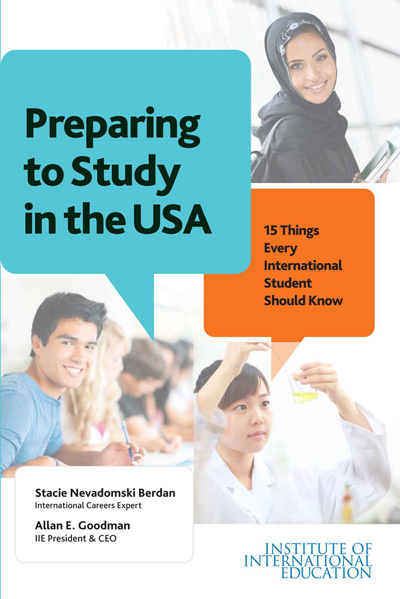
Why are sports so important in U.S. college culture? Am I allowed to express my own opinions, even if I disagree with the professor? These are some of the most common questions international students ask when they arrive at an American university or college. The United States offers a rich and dynamic higher education system that attracts more international students than any other country in the world. U.S. colleges and universities also actively seek international students to facilitate cultural exchange among students and internationalize their campuses. But the variety offered by the country’s more than 4,000+ colleges and universities can also be a source of confusion.
To help students understand and succeed in the U.S. education system, I’ve teamed up with Allan Goodman, President of the Institute of International Education (IIE), to write our third student guide, Preparing to Study in the USA: 15 Things Every International Student Should Know.
This new book – available in paperback now and as an e-book in May – offers practical advice and cultural insight to students, including how to:
- Understand the Value of a U.S. Education: Critical thinking and a liberal education can give international students a competitive edge in the global job market.
- Identify Resources for International Students: A variety of resources are available for international students seeking or enrolled in U.S. higher education that offer students a wealth of information to ease their integration and immersion, including the U.S. Department of State’s EducationUSA network of advising centers around the world and on-campus resources such as the Registrar’s office, student advisers and health services.
- Choose the Right School: Public versus private, urban versus rural, small versus large are just a few of the factors explained and important to consider in finding a good fit among the more than 4,000 institutions.
- Calculate Costs: Tuition, room and board, textbooks, financial aid and scholarships are some of the biggest factors that are involved in calculating the difference between a university’s published price and the net (or actual) cost.
- Get Involved in Campus Activities Beyond Academics: Taking advantage of the rich array of clubs, sports, interest groups and diverse student population can help students explore new passions and become a more well-rounded and attractive candidate for future employers.
- Navigate Campus Life: U.S.-style dorms and dining halls, Greek life, sports and fandom, and a robust party scene found on most campuses may be overwhelming to students who have little direct experience with U.S. lifestyle and culture; therefore, a little explanation and interpretation from fellow students and advisers will go a long way.
- Stay Safe Far From Home: Being prepared, staying informed and understanding the local laws are critical for dealing with the inherent risks in traveling and living abroad.
- Get Work Experience in the U.S. After Graduation: Taking advantage of the opportunity for Optional Practical Training (OPT) is one possibility explained for students on an F-1 visa to remain in country after graduation to get valuable work experience in their disciplines.
In 15 short chapters, Preparing to Study in the USA addresses the most critical issues facing international students as identified by U.S. international student advisers, accompanied by three Frequently Asked Questions at the end of each chapter. FAQs include:
- How can I find out if a school I am thinking of attending is accredited?
- What if my TOEFL scores do not meet requirements?
- How do I choose my major?
- If I want to be a professional, why do I need a liberal arts education?
- How do I get an adviser?
- What is academic freedom?
- Why are sports so important in U.S. culture?
- Why shouldn’t I live with students from my home country?
- What do campuses do to help students deal with stress?
Print copies of Preparing to Study in the USA are available from IIE Publications for $4.95 USD, with a steep discount for bulk copies for schools to give out to students (20 copies for $20.00 USD). E-books go on sale for $2.99 in May at IIE Books.
Creating a #NationofAdvocates: From 90% Target Language to 90% Retention
Posted on Apr 11, 2016 5 Comments
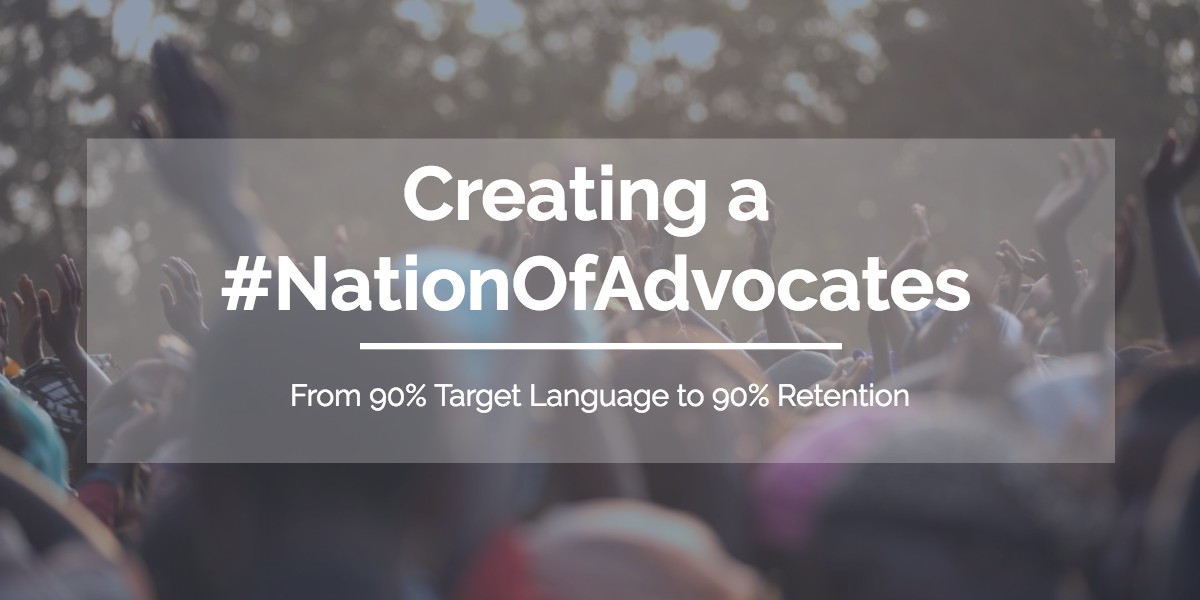
Guest blog by Grant Boulanger
Developing a global mindset and intercultural competence is not just for the global traveler. The ability to trust, respect and honor our neighbors and their traditions hinges on a capacity for empathy. In world language classes, that empathy begins with explorations of identity in our languages and building communities of trust. World language programs prepare many for global travel and business pursuits, but, more importantly, they should prepare students to be accepting of, celebrate and contribute to our pluralistic society. Successful language learning for all students will make us all better people. But we have hurdles to overcome and the place to begin to address them is the novice-level language class.
One issue of pressing concern from an equity standpoint is retention of students of color and male students of all races. In the latest edition of Foreign Language Annals, the official journal of the American Council on the Teaching of Foreign Languages, Dr. Hannah C. Baggett from Auburn University writes “African-American students are underrepresented in language courses and … African-American and Latino students are underrepresented in advanced placement courses broadly speaking. African-American and Latino male students were under represented even at more diverse schools, and white female students were consistently overrepresented in language classes, despite demographics and language offerings.”
Dr. Baggett shares the results of a study she conducted of more than 200 secondary schools in North Carolina. Her study confirms disparities in language learning opportunity and achievement for students of color:
- Students of color are underrepresented in language courses.
- Students of color are underrepresented in AP classes.
- Schools with majority students of color have fewer language options.
- African American and Latino males are underrepresented in upper levels.
- White female students are overrepresented in upper levels.
According to the 10th Annual AP Report to the Nation, females outnumber males in advanced placement testing in all languages except German. John DeMado’s triangle of enrollment demonstrates that retaining students at upper levels in traditional secondary language programs is not a new phenomenon. But Dr. Baggett’s study specifically brings to light disparities in enrollment opportunity and achievement potential among students of color. Conversations must shift from simply retaining students to ensuring that programmatic and pedagogical decisions intentionally acknowledge and address educational equity for students of all backgrounds.
Language educators are gatekeepers. We impact students’ ability to be accepted by post secondary schools. When students of color are underrepresented in our upper level classes, these students have less access to selective schools, which often require more than a two year minimum. As public educators charged with educating all our students, we are obligated to acknowledge and address these disparities.
There are many factors that contribute to language offerings and enrollment in public high schools across the country. As classroom teachers, we have little direct control over many of them. If we choose to respond by saying that underrepresentation of certain subgroups at upper levels is outside of our control, how do we explain the phenomenon Dr. Baggett has documented? Are we prepared to say that white females in North Carolina just acquire language better than Latino or African American males?
If a person isn’t ready to make that assertion, and I hope they are not, then there must be instructional decisions we can make to better address issues of equity in our world language classes. Which contributing factors are within our own scope and power as language teachers? How can we ensure that as many students as possible will have the confidence and competence to continue on in their language courses? How can we create a #NationofAdvocates? Let us concern ourselves with the human side of the equation.
A former colleague once confided in me that she considered it her duty to decide who was “fit” to move on to upper levels and who wasn’t. Students routinely share with me that despite their desire and intention to continue learning languages, they don’t perceive classes to be relevant to their lives. Additionally, when the focus is on learning about the language, with an unbalanced emphasis on manipulating discrete elements of the language, we unintentionally advantage some students. Well-meaning teachers may inadvertently be contributing to the problem. What we teach and assess, how we teach it and, most importantly, why we are teaching are all factors that contribute to the confidence and trust our students have in us and in the language learning process. Without high levels of confidence and trust, our students will not voluntarily enroll in higher-level language courses.
We need to make intentional decisions to acknowledge and address disparities and explore and adopt classroom practices that mitigate them. I believe that the front line of this work is in the novice-level language classroom. If students are to embrace and develop global mindsets, they have to want to come back tomorrow. We alone are responsible for creating language classes that are meaningful and relevant, engaging and fair, joyful and effective. This must be our contribution to the solution.
We as teachers can decide to adopt practices that could increase enrollment of all our students. Here are some practices that have helped me create a space where all kids want to come back tomorrow:
- Engagement – Learn to engage with our students in real, human to human communication about topics that matter to students and in ways students understand and can contribute to. Do not assume that engaging is something we do to our students, but rather with them.
- Community – Focus intentionally on building positive peer connections and creating a more joyful experience for all members of the class.
- Personalization – Find ways to customize content to make it more meaningful and relevant to the students who are in your classes at any given time. This will change from class to class and month to month.
- Equity – Promote equity by collaboratively analyzing enrollment trends to ferret out inequities in our programs and create and monitor department goals to raise enrollment of underrepresented subgroups.
- Comprehension – Use what we know about second language acquisition. A balanced and equitable grading system does not necessarily mean equal weight on all modes of communication in all levels. In our novice-level classes, SLA research compels us to give heavier weight to listening and reading comprehension, since that is the work of the Novice, and to acknowledge that production and accuracy develop over time. Emphasizing comprehension allows all of our students to experience high degrees of success, without added anxiety associated with production before they are ready. In my classes I find the less I make them speak, the more they want to.
- Proficiency – Adopt practices that lead to real and measurable proficiency. Recognize that our students sign up for our classes because they expect to learn how to use the language, not learn about the language.
As a profession, we language educators are now on board with 90% target language use at all levels in the classroom. We know and understand that our students acquire language when they understand, interpret and respond to meaningful messages. But what good is that if we cannot find a way to bring language acquisition to ALL kids? We must develop and share principles and practices that will raise engagement, address inequities and create joyful, successful experiences for all our students. 90% retention is what we need to create a #NationOfAdvocates.
Follow Grant on Twitter #NationOfAdvocates #languagematters #leadwithlanguages #flteach #langchat #mfltwitterati #mfl #spanishteachers #Raisingglobalchildren

Grant Boulanger, 2016 Central States Conference on the Teaching of Foreign Languages Language Teacher of the Year, is a level 1 Spanish teacher in Oakdale, Minn., and a 2017 American Council on the Teaching of Foreign Languages Teacher of the Year finalist.
Leadership for Gender Equality
Posted on Apr 7, 2016 1 Comment
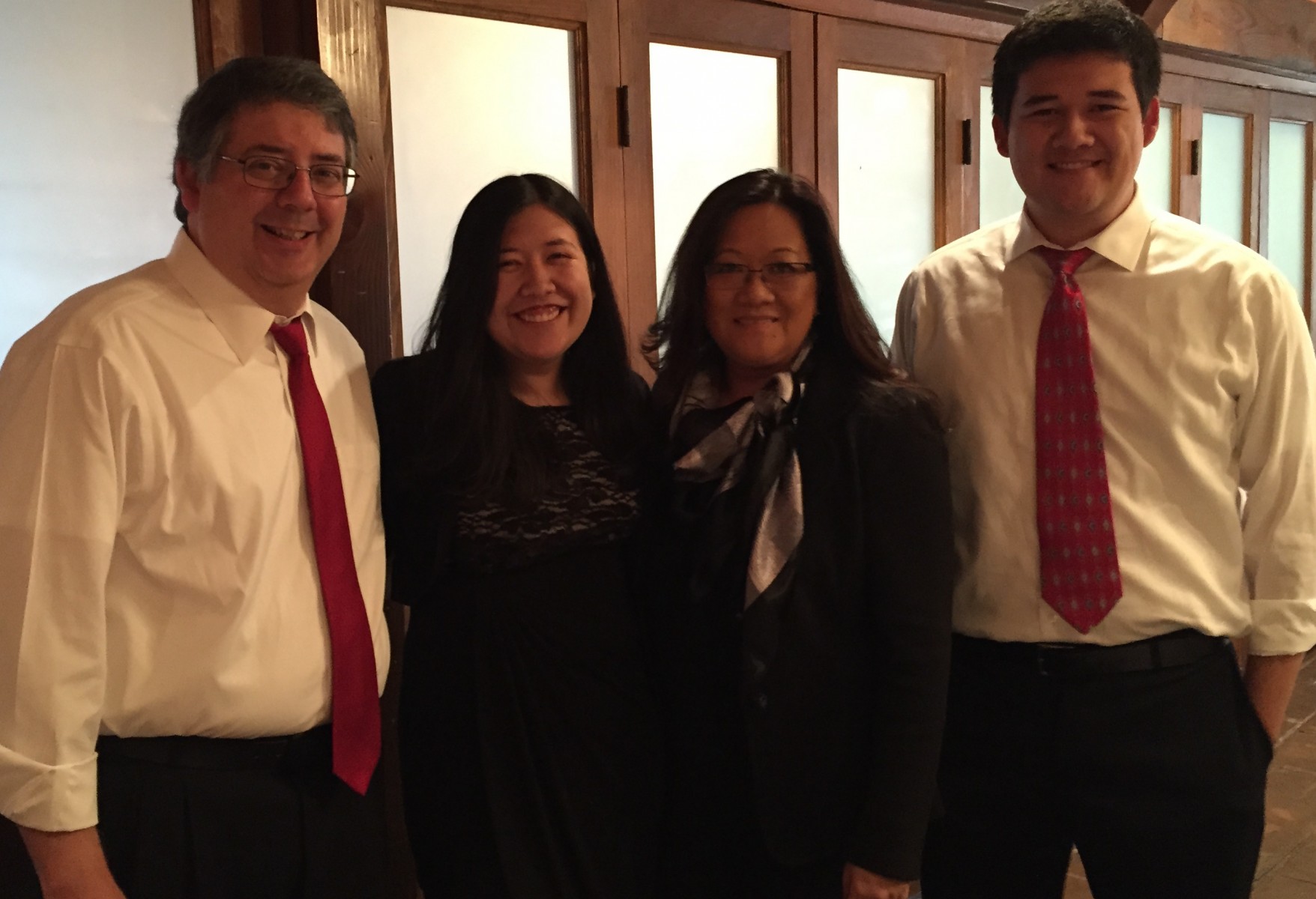
Guest blog by Anna Catalano / @accatalano
Every March over three decades, we celebrate the impact that women have in America during Women’s History Month. As we celebrate some of the progress made, we realize that the pace of change is far too slow. Recent studies show that women still earn only 78% of what men are paid for the same job, and that gap increases even further for women of color. Statistics indicate that the percent of executive positions held by women have increased from 13.5% to 14.6% from 2009 to 2013, and progress in the boardroom is equally stagnated.
When it comes to raising a family, we continue to struggle for respect for women who choose to stay home, and the U.S. trails much of the developed world on issues of childcare support and paid family leave legislation. Finally, women and girls are held to difficult expectations on physical appearance as society continues to define feminine beauty with impossible standards.
For every one of these issues, there are organizations, social media groups, mentoring programs, and advocacy efforts designed to change the world for women. As important as these efforts might be, perhaps closer examination is needed in one of the most important roles we have — that of how we raise and influence our children.
Indeed change takes time. But if we fail to create a greater sense of urgency around how the next generation views issues of gender equality, we cannot expect the will of organizations and advocacy programs to make it happen. After all, those efforts are led by human beings who hold values and biases that are well-formed by the time they are given the responsibility to lead. Those of us who have the opportunity to shape those values and biases should consider the following:
Talk to kids
In a world of constant connectivity, we are becoming increasingly disconnected. Having thoughtful conversations with kid about work, school, friendships, and health all provide opportunities to convey quality messages about how men and women can/should feel and interact. Discuss news reports that cover issues of gender bias, and ask kids what they experience with friends. Engaging on this topic will make them realize that they can be part of making things different.
Examine your gender biases
You have them. We all do. Realize how much biases have evolved since your parents’ generation (not long ago, women were required to quit work when they became pregnant!), and make a commitment to continue that journey for the future of the children you influence. Do you place an equal level of importance on the education and independence of your daughter as much as your son? Do you subconsciously feel that it’s less important for a girl to demonstrate success than a boy? Examine these, and realize how they impact what you say and how you behave.
Fill your children’s lives with great gender role models
The impact that role models have in our lives is tremendously important. They are examples of the professional, personal, and ethical behaviors that we strive to achieve. It is essential for children to have, in addition to their parents, adults who represent a standard for which to strive. Role models can be teachers, neighbors, church leaders, family relatives, or friends. Have conversations about what makes them great people, how they achieved their happiness and success, and encourage your children to build strong and healthy relationships with each of them.
Find opportunities to travel or live abroad
Nothing opens the eyes of children more than having a chance to interact with people from other parts of the world. Models of what men and women do vary in other countries, and experiencing those differences can lead to insights and conversations that can shift biases that we hold. In countries where education for girls is not as strongly endorsed as it is for boys, opportunities for women are far more limited. On the contrary, where gender equality is more prevalent, it is easy to see both social and cultural support systems that make that possible.
Include gender implications in milestone conversations
In addition to everyday conversations and activities that reflect your beliefs about gender issues and challenges, be sure to carve out opportunities to include the topic in “milestone moments” such as graduation, marriage, first jobs, and other life events. Young adults are constantly faced with choices and opportunities to formulate their beliefs about gender issues throughout their early years. If a daughter is heading off to college, provide reinforcement about the importance of the next few years as an investment in her future career. If a son is about the start a new job, remind him about how important it is to value the contributions of all of his colleagues, and to realize the particular challenges of young women colleagues at work.
Build self-esteem and confidence in both boys and girls
Encourage activities that require collaboration as well as those that are competitive for both boys and girls. This emphasizes the importance of both individual effort and teamwork, and teaches at a young age that the best result is often only achieved with the help of many different skills. Strive to find the special gifts of all children, and resist the temptation to “channel” them into areas of interest that suit preconceived biases. Most importantly, don’t play into the mentality that boys need to be tough, and girls need to be soft. The two traits are not mutually exclusive, and in reality, don’t we want to find them both in both men and women?
I’m often asked when I speak about gender issues in the workplace what I consider to be the most important factor in making things different. My answer has always been the same: “It’s about how we raise our kids”. The pace of change is excruciatingly stalled. It’s our fault. We’re raising kids who have the same biases that we are trying to change. We must take a good look at ourselves; at the experiences we bestow upon our children, the modeling we provide, and the evidence we demonstrate.
————————-
Anna was one of the six women featured in Get Ahead By Going Abroad: A Woman’s Guide to Fast-track Career Success. To read more about Anna’s perspective on leadership, check out her blog, Shades of Leadership.

Anna Catalano is a board director, a wife, and a mother of two, and involved with organizations and causes that are making a difference in the world.
Sunnier Prospects for US-ASEAN business opportunity
Posted on Apr 3, 2016 Leave a Comment

Guest blog by Curtis S. Chin and Peter N. Wainman
America’s welcome mat is out. This past February, for the first time ever, U.S. President Barack Obama played host to all 10 leaders from the Association of Southeast Asian Nations at the historic Sunnylands estate in Rancho Mirage, California.
That is good news for the US and for all 10 nations of Southeast Asia. U.S. attention is rightly turning to what remains one of the most dynamic regions in the world.
This added dimension or refocus, if you will, of America’s so-called rebalance or “pivot to Asia” could not be more timely. As economic growth in and consumer demand from Asia’s traditional power houses of China and Japan continue to slow, and the promise of India is still yet to be realized, a deeper partnership between the United States and ASEAN will benefit entrepreneurs, businesses and consumers on both sides of the Pacific eager to go global.”
This relative rise in ASEAN’s attractiveness for foreign firms comes as China’s falls. Inconsistent regulations, murky laws and perceived growing anti-foreign sentiment in China in particular have led businesses to look beyond the Middle Kingdom for growth prospects.

SINGAPORE: As Asia citizens increasingly worry about health hazards ahead amidst polluted skies and water, new opportunities exist for companies going global with technologies and products to meet growing consumer needs.
A recently released annual survey of members of the American Chamber of Commerce in China makes this all too clear. According to the Wall Street Journal, of the nearly 500 companies that responded to the survey about China’s business environment, some 77% felt less welcome than they did a year ago. This compares with 47% in 2015, and 44% the year before that. One in 10 had already moved or planned to move a portion of their business outside of China due to regulatory obstacles.
And while 68% of the companies responding to the survey said they will still increase investment in China, 32% say they have no plans to do so – the highest level expressing such a sentiment since the global financial crisis.
Foreign businesses ranging from Apple to Qualcomm have been the targets of state-run Chinese media reports and government investigators. And foreign car and auto parts makers, tech companies and infant milk powder businesses have all incurred fines under China’s anti-monopoly law.
One U.S. food-processing company OSI Group LLC saw 10 of its employees, including its Australian general manager in China, sentenced to prison after a Shanghai court ruled that the Aurora, Illinois, headquartered company had sold “inferior products” to fast food chains. OSI is now reportedly appealing the court decision. The supplier of meat products says that it has been the subject of a smear campaign and that Chinese authorities had unjustly held OSI employees for 17 months as well as barred company leaders and media from attending the trial.
With business opportunities like that, it is no wonder that there is already more U.S. investment in Southeast Asia than there is U.S. investment in the so-called BRIC nations – Brazil, Russia, India and China – combined.
What a welcome contrast ASEAN offers. Indeed, the U.S. president was wise to spotlight the just launched ASEAN Economic Community at the first US-ASEAN Summit in California. With the launch of the AEC now past us, the hard work of leveraging what promises to be a world-leading single market formally begins and U.S. business can be very much part of that.
The opportunity, stemming from freer if not yet fully free trade of goods, services, and skilled labor, provides a wealth of potential new business for Southeast Asian entrepreneurs and start-ups willing to take advantage of them, including American companies and individuals already established in the region. That, at least, is our experience in Southeast Asia’s dynamic start-up environment.
Indeed, as a driver of economic growth, the AEC’s growing business benefits need not go simply to the region’s largest and oldest companies. Much as the United States has benefited from the power of innovative start-ups – some headquartered not so far from the site of the Sunnylands summit – so too can the ASEAN nations transform and grow as trends are identified and new businesses emerge in areas from information technology to consumer goods.
Ernie Bower, chair for Southeast Asian studies at the Center for Strategic and International Studies in Washington, D.C., and CEO of BowersGroupAsia underscores the opportunity. “The AEC opens doors for entrepreneurial small and medium sized companies within Southeast Asia to access nearby markets that are in some cases more dynamic than their own and offer up a larger market segment for their goods or services than ever before,” he says.
One clear benefit of the AEC is a market that goes well beyond one’s own borders. With more than 620 million people, ASEAN’s population now exceeds that of either the European Union or North America. There is ample scale for significant growth even if one is based in Brunei or Singapore instead of the region’s most populous nations of Indonesia and the Philippines.
That’s an experience and an opportunity we are already seeing in our own work with Equator Pure Nature (EPN), a Thailand-based manufacturer of natural household cleaning products sold under the PiPPER STANDARD brand. It’s also a case study for others looking to the path to AEC success. 
So, what lessons do our experiences offer others eager to expand in the AEC based on the rhetoric and reality that may well be highlighted at the US-ASEAN Summit?
First, recognizing that production inputs are only half of the equation for success. The other is identifying a specific opportunity based on ASEAN data and trends. Rapid urbanization and economic growth across the region has produced a host of needs that can be identified through an entrepreneur’s eyes. ASEAN’s environmental challenges, burgeoning allergy and asthma rates and persistent food security and nutrition needs are just some examples.
Second, understanding success in ASEAN and now the AEC is not something to be expected instantaneously. Research and development over several years is critical to developing an appropriate solution to an identified need. Identifying and investing in local human capital is also essential to steady growth.
And third, establishing a firm foundation in a single ASEAN market – in our case Thailand – allows for better understanding of the regional market and can serve as a hub for expansion. Multinational firms big and small would be

With a growing Southeast Asian consumer market drawn to mascots and the products they represent, emerging companies like Equator Pure Nature are putting their marketing skills to work.
wise to plant operations in one of the 10 ASEAN countries to have better access to new markets and to establish rapport with regional consumers.
Symbolically, the site of this first landmark US-ASEAN summit in California was the same venue used as the site of a meeting between Obama and his Chinese counterpart Xi Jinping some two-and-one-half years ago. Perhaps at last, the US-ASEAN and US-China relationship will now be viewed in Washington at the same level of importance.
The Southeast Asian welcome mat has long been out for American businesses and entrepreneurs. With the window to the AEC now open, significant investment is likely to follow by the region’s largest firms eying significant opportunity. But, the size of a firm need not dictate the size of the opportunity.
For businesses, big and small, a healthy business in one Southeast Asian market can now lead to more opportunity and strengthened growth across all 10 ASEAN markets – and from there, opportunity across Asia and the Pacific. That at least is the promise of the ASEAN Economic Community, as China and India lose some of their luster. Now the challenge is also for businesses – building on the message of Sunnylands of sunnier days ahead – to meet that challenge.
Note: A version of this opinion piece was published in the Singapore Straits Times.
Follow Curtis @CurtisSChin and Peter @PipperStandard

Curtis S. Chin, a former U.S. Ambassador to the Asian Development Bank, is a member of the advisory board of EPN and Asia Fellow, Milken Institute.

Peter N. Wainman is CEO and Chairman of Equator Pure Nature (EPN).
Sealing the Deal on Biliteracy
Posted on Mar 30, 2016 Leave a Comment
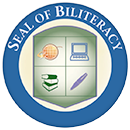
I enjoy the diversity and beauty the U.S. has to offer, especially when it comes to heritage and immigrant populations and their native languages. As a second-generation American whose parents grew up speaking Polish at home, yet who chose not to teach it to my siblings and me, I’ve always felt a twinge of envy when I meet people whose parents did continue both the language and cultural traditions of their countries of origin. Often our country insists immigrants adapt and leave “the old world behind”. That is certainly what my grandparents wanted for my parents as they adapted to the “American way of life” for most of the 20th century.
But times have changed, and both business leaders and educators have begun to recognize the importance of tapping the 350 languages spoken here. Yes, learning English is an imperative to succeed in the U.S. – and the rest of the world – but there is no reason why we shouldn’t promote both English and a native or second language.
It seems I’m not alone in my belief. There has been a quiet yet powerful and progressive trend taking place across the U.S. in state capitals, where legislatures are passing a State Seal of Biliteracy. The Seal is awarded by an individual school, school district or county office of education to students who have studied and attained high proficiency in two or more languages by high school graduation. Language skills are measured by national exams.
Students who receive the Seal may have a gold seal placed on their transcripts and diploma, be awarded a medal, or have a simple line added to their transcripts. But the result is the same: proof of biliteracy to college admissions offices and future employers. The Seal of Biliteracy acknowledges students’ hard work and achievement in their pursuit of a new language. Any student who masters English and a second language, be it a native language spoken at home or a world language studied in school, can be awarded the Seal.
The Seal began as a movement by parents, teachers, education advocates and civil rights groups in California both to improve education for non-native English speakers and to encourage language study in schools. The coalition helped implement the program across the state, and in 2011, California became the first state to pass legislation around a State Seal of Biliteracy.
Since then, 12 states have passed legislation creating a State Seal program: Texas, New York, Illinois, New Mexico, Washington, Louisiana, Minnesota, Washington, D.C., Virginia, Indiana, Nevada and Hawaii.
Right now, my state of Connecticut is in middle of seeing its own Seal of Biliteracy passed. On Wednesday, March 16, the CSDE Education Committee passed the Seal of Biliteracy unanimously with modified language, and now the bill is currently up for consideration for vote in the General Assembly. If you’re interested in learning more about the CT Seal of Biliteracy getting involved, go to the COLT website.
Tireless lobbying efforts of parents, teachers and other education advocates have progressed 15 more states closer to passing legislation.
Parents are crucial to the success of the State Seal of Biliteracy. The Seal supports our goal of preparing our children for today’s global marketplace. It encourages language learning from an early age through high school, rewarding those who master a second or third language. A Seal for high school seniors not only appeals to colleges and employers, but can save money for parents by eliminating language credits at the university level.
I started getting involved as a professional and parent when I learned about the Seal from colleagues in Illinois, Indiana and Minnesota and have been actively engaged with the Connecticut group working toward the Seal in our state. Here are some ways you can get involved:
Ask your district school board about the program. In states that have already passed legislation for a State Seal, it is still up to individual school districts to adopt the program. Talk to the district board about incorporating the program in your district. Approach them with a coalition of parents, teachers and education advocates so they can understand how important the issue is.
Inquire about the Seal in your child’s school. As more parents ask about the Seal and how their sons and daughters can attain the merit, more schools will begin considering implementing their own program. High school parents especially should ask about the program if their children can pass tests in English and another language, but also to provide them with an incentive to continue studying Spanish, French, German, Mandarin or other languages available throughout their four years of high school.
Contact your state representatives. Call, write or visit your state representative to convince him or her of the importance of the Seal of Biliteracy, and to start a bill that would create a state-sponsored program. They don’t cost much—if anything—to run, but the students benefits are great.
Advocate for mandatory world language learning in your school and/or district K-12. Whether you have a full or partial language program, show your support with teachers, principals, PTO/PTA and board of education members. Encourage your children to take the subject just as seriously as others. If you have no program, create a group of like-minded parents who want to build a language program and start advocating. Studies show that language learning comes more easily to those whose brains are still in the development phase – up until roughly 13 or 14 years of age. Parents with children in elementary schools should push for early language education since the Seal requires these programs to survive.
Gather together with families who speak another language at home. Heritage speakers are great supporters of the Seal. They pass their language along to their children who are able to communicate verbally in the language, but may not be able to pass a writing or reading test. The Seal of Biliteracy enables these students to become completely proficient.
The Seal of Biliteracy encourages language learning from an early age and celebrates it—something that has disappeared in today’s school districts across the country as language programs are cut just when we need them most. Get involved. Make a difference. Join the movement: #2bilit2quit
Balancing a Big International Job and Little Kids
Posted on Mar 8, 2016 Leave a Comment
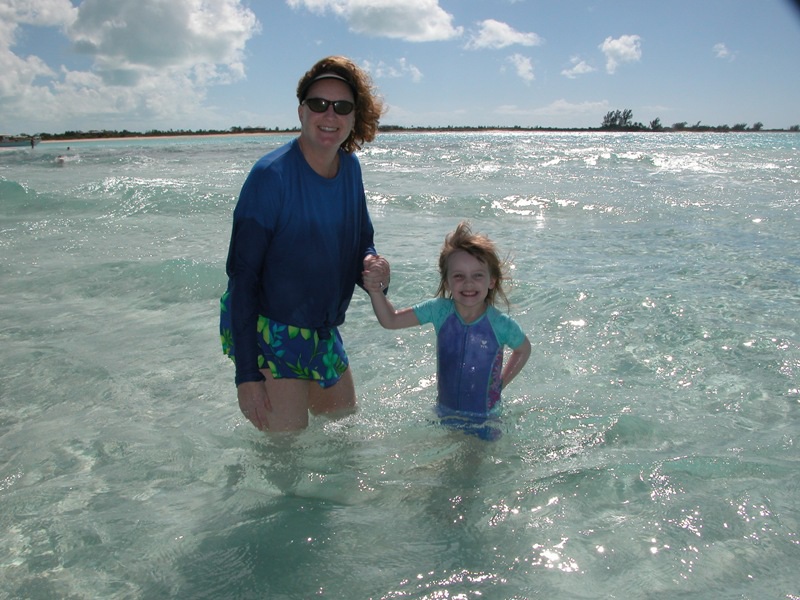
Guest blog by Perry Yeatman
As I sit here, on yet another United flight, waiting to leave for my current home town of Annapolis, Maryland, my thoughts wander, as they often do on planes, to my family. Throughout my career, people have asked me how I juggle big global jobs and a family. The simple answer is: it isn’t easy. It requires some sacrifices, and you have to really work at it. But for me, it’s been sooo worth it! If you think this might be for you as well, here are a few tips I’ve found that really help.
Aside from picking the right spouse (a critical success factor for every working mom, but one that deserves its own blog — if not entire library section — so I’ll leave that for another time), I recommend nine things anyone with a big job (and especially a big, international job) can do to help improve work/life balance, especially with small and school aged children:
- Set the right expectations up front. Before I joined Kraft in 2005, I made it clear to my boss I wouldn’t “give up” my then two-year-old daughter by traveling two-to-three weeks every month as I had earlier in my career. So we agreed performance was what mattered and how much I traveled was up to me. Then I had the same honest, direct discussion with my team.
- Eliminate your daily commute. If you are going to have to travel for work, you need to minimize your daily commute so you can be home as much as possible every day that you are in town/in the country. One of the reasons we moved to the North Shore of Chicago was so that I could have a global job (150+ countries) and a 15-minute commute.
- Travel only when truly necessary. Since I’ve lived and worked up and down the East Coast and literally all over the world, there are few markets I don’t know something about first hand. Therefore, I don’t need to spend a lot of time on the road just getting a sense of what my company and my team are facing. I travel when I really need to, but I’m a huge fan of virtual meetings and my teams have been great about working that way too. (P.S.: I’m also a huge fan of getting in a lot of miles before having kids so that you can have a similar career advantage — not to mention all the fun of seeing the world!).
- Use your plane time. I used to love reading books or watching movies while flying. These days, plane time is almost exclusively for working or catching up on sleep so I’m ready to play/engage with the family when I walk through the door.
- Minimize jet lag. I don’t use an “over the counter” remedy to deal with jet lag anymore. I just avoid it or gut it out. For example, if I have a meeting in London, I will fly in that morning, work a full day, have an early dinner with the team and then head to the airport to catch the last flight back. Ditto with LA. I may be tired but I never suffer jet lag since my body never really leaves local time. It also means that in my daughter’s eyes, going to London is no different than going to New York as I can be home for dinner on Monday night and back by bed time on Tuesday.
- Pack light. I can travel for three weeks in a carry-on bag. This is important. It saves hours each trip since I don’t have to arrive at the airport as early. I don’t have to wait in baggage claim lines. And I don’t
have to debate each morning what I’m going to wear. Combined, this often means the difference between getting in a work out or making it home before lights out. - Join Global Access. Similar to my point above, if you live in the USA and travel overseas a lot, I have found TSA-pre and Global Access to be god sends in saving time and reducing hassles. My advice: sign up today!
- Stagger trips. Unlike some people who choose to hit the road and just keep going, I find children need frequent quality time so I try not to travel back to back. My rule of thumb is not to be gone for more than four days at a time and to try not to travel — at least overseas — on consecutive weeks.
- Make them part of the adventure. On short trips, even though she may not be traveling with me, I make sure to talk with my daughter about where I’m going and to show her pictures, etc., to get her involved in “mommy’s big adventure.” Much to the surprise of her day care providers then and 6th grade teachers now, she has quite an advanced world view. By three, she could readily identify the Eiffel Tower, the Great Wall of China and Moscow’s Red Square. And she knew about a wide variety of subjects – from Buddhism to the Vikings. At day care, she loved to tell people about where mommy had been. Then on the occasions when I’d have to be gone for more than a week, like when traveling to Asia Pacific, whenever possible, we all went together. My husband loves to travel and the kids (my daughter and my older stepson) have always been absolute travel troupers. So as often as possible I’ve taken my family with me. From Australia to Abu Dhabi, my job has let me show my family the world (on my own dime of course). And by bringing them along, it has ensured that I have been able to remain a central figure in their lives, not just someone who shows up on special occasions. Indeed, the whole family could be described as true global citizens — at ease with foreign languages, foreign cultures, foreign foods in a way that I never was before actually moving overseas. What a gift! These days, instead of telling her day care providers what mommy did, my daughter loves telling her teachers and classmates what she’s done. And with 3 passports, 4 continents and 20+ countries under her belt by age 11, she has a lot to share!
These are some of the things I do to make it work for myself and my family. Granted, having a big job and working globally is not for everyone, and it takes a really supportive spouse. But I’m living proof that if you want it you can combine a young family and a global career and you can reap big rewards — personally and professionally — by doing so.
Perry Yeatman is CEO of Perry Yeatman Global Partners and External Director at Mission Measurement. She co-authored the award-winning book, Get Ahead By Going Abroad, with Stacie Nevadomski Berdan. @perryyeatman
Experiential Learning in the United States and Beyond
Posted on Feb 18, 2016
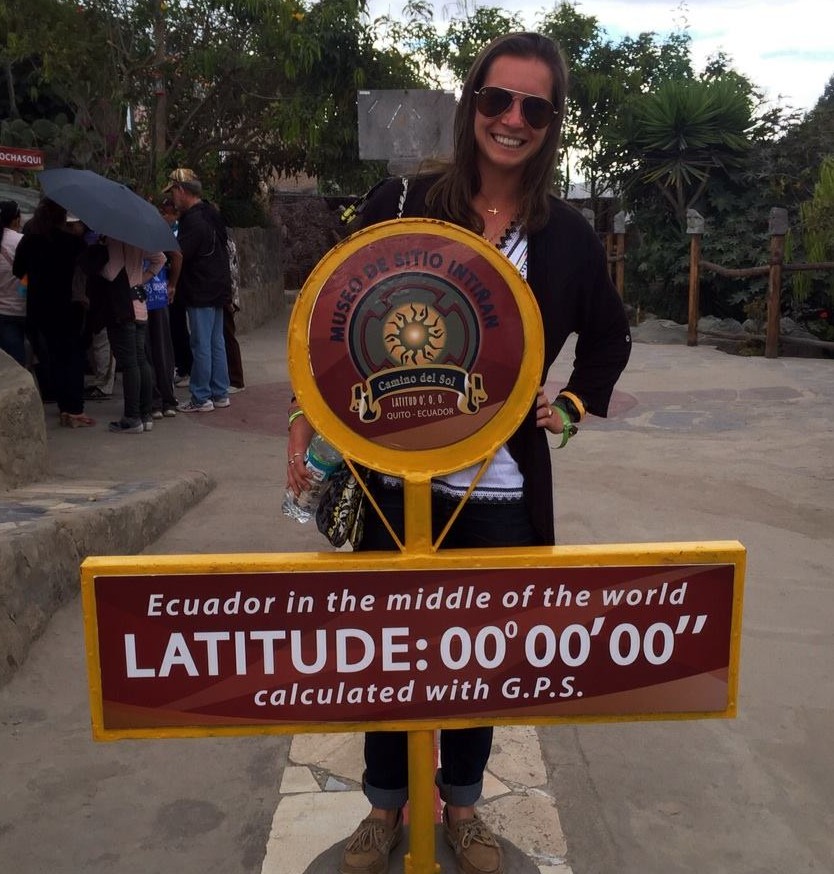
Guest Blog by Morgan Abate
One of the things I love most about my university is its commitment to engaged, experiential learning. It encourages studying abroad, experiencing other cities in the United States, hands-on learning, teacher-student relationships, simulations and research to enhance the education that happens in the classroom. Because of that culture, I have been able to study abroad three times, create several portfolios of written and multimedia work, work one-on-one with professors, and participate in Model U.N. and poverty simulations.
More than that, though, my higher education has provided me the opportunity to meet people from all over the world in a tiny university town. I have lived with students from around the globe; roomed with a girl from Ghana who has become one of my best friends; discussed American politics with an Indian citizen residing in Singapore; felt the fear of Nepali friends whose homeland experienced mass destruction; and spoken Spanish with native speakers who appreciate that I make an effort.
This type of immersion, though, does not just happen. One needs to search for it on and off a university campus. Whether you are studying abroad or in a different city in the United States, culture surrounds you. If you’re seeking cultural experiences while in college – which you should to prepare yourself for an increasingly globalized world that relies on bilingual and bicultural skills to be successful – here are some things that you can do based loosely on some of the experiences I have had.
Look for a language or international living-learning community
The easiest way for me to find diversity and culture on campus was through themed housing. Many people with whom I became acquainted my first year lived in an international learning community where students interested in other cultures and from other parts of the world gathered to celebrate each other. I applied to live there my second year and have never left.
Many universities have themed housing, which usually requires an application. By targeting a specific housing arrangement for yourself based on culture, you can find yourself living with someone from a different country, religious background, or first language. At first it may seem inappropriate to inquire about students’ backgrounds, but that is the beauty of themed housing. Those types of conversations can happen naturally and in a safe, nonjudgmental environment.
Offer to help with an international student orientation
There is always orientation for students: new students; transfer students; and international students. International students – whether they are in the U.S. for a semester or for four years – have an orientation to get them acclimated to the culture, language, U.S. higher education system and the particular university. I personally never helped with these orientations, but I knew the students who did. I would show up to open events (many times enticed by the free food) to get to know some of the newer students. They had plenty of resources via their orientation leaders, but I wanted to offer them another one as a domestic student and to simply extend a hand of friendship.
Explore the world by engaging in conversation with those around you
Through friends of mine who ran the international student orientation for the spring 2016 semester, I was able to go to dinner with a group of students to talk. Many of them seemed overwhelmed and frightened. They remained quiet for much of dinner, listening to their leaders talk.
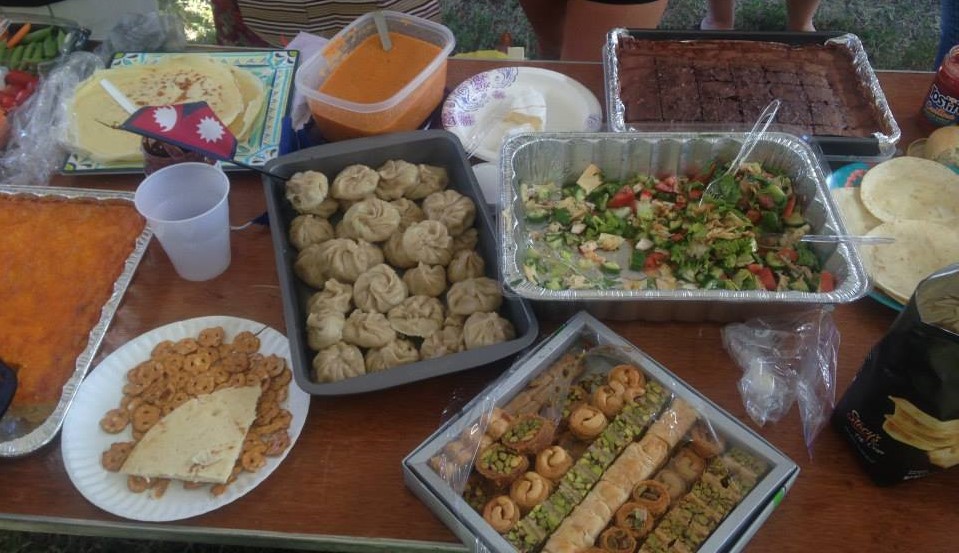
Through an international tailgate, members of the international and U.S. communities can start conversations about where the food comes from, what it consists of, and how and why it is eaten.
When we moved to a local coffee shop, I sat with a third-year business student from Syria. I’ve met her once or twice, but never had an in depth conversation. I asked her what she did for break, to which she responded that she went home to Damascus. I found it hard to ask her about the situation in the country and the difficulty with getting there and back to North Carolina: media reports make it seem as though the entire country is in shambles. Another transfer student sitting with us lived in Lahore, Pakistan. There were so many questions I had but didn’t know how to phrase without seeming, well, American. Naturally, though, the conversation shifted and I heard stories of their countries from their perspectives – not the media’s. I left that coffee shop a little more enlightened than I had been.
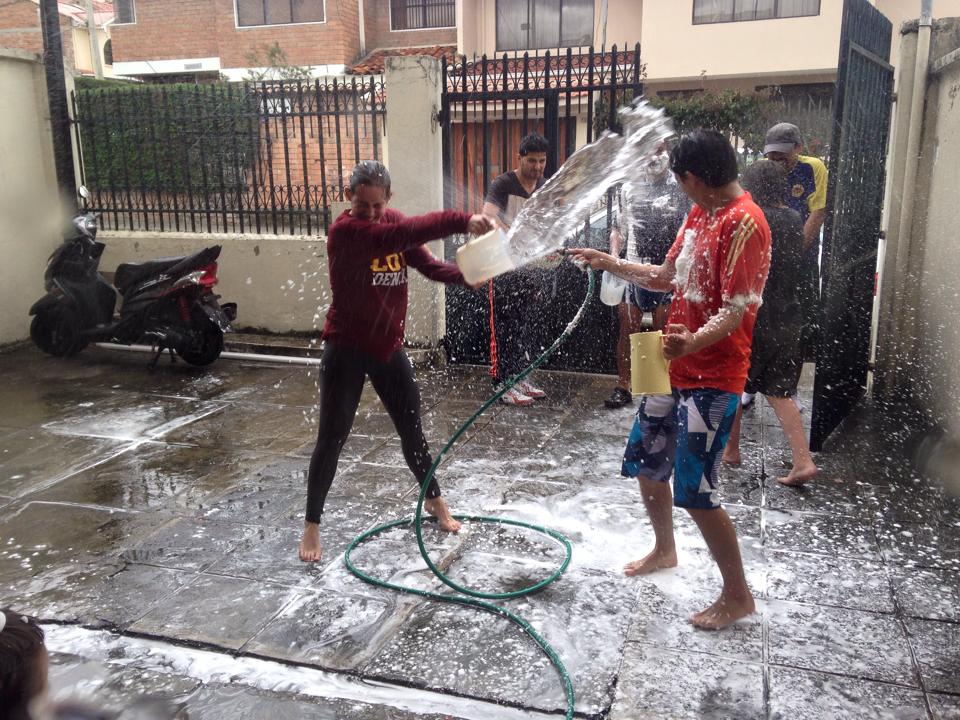
One of my host cousins and I threw water at each other constantly during Carnival, the day when I truly felt welcomed to the country.
Learn or practice a language with a native speaker
My university has a growing Spanish-speaking population, which has made it easy for me to continue using my Spanish-language skills as well as immerse myself in Latin culture. But for students who look to speak Mandarin, Arabic and even French, it’s much more difficult to find spaces to practice. By making friends with native speakers, not only are you helping yourself, but you are, in a way, helping the students who might not have someone with whom to converse on a daily basis. Native speakers are always pleasantly surprised to find people who want to speak to them. It’s a way to celebrate a culture and also feel a little bit more accepted. If it’s hard to find students who speak a critical language, there are a lot of online groups you can join to video chat with others who are learning English.
Experience a different culture and enhance language skills by going abroad
I spent three weeks in Costa Rica understanding Latin culture, five months in Cuenca, Ecuador speaking Spanish 14 hours a day and picking up some Quechua along the way, and two weeks in Honduras teaching young men about gender-based violence. Every experience taught me something new about the language, the culture, the cuisine and myself. Going abroad teaches you how to live in another culture, to navigate it in a language that is not your own, to listen more attentively and to understand what the world outside of your hometown or university looks like.

Who knows — living and learning from someone (seemingly) different from you can lead to a lifelong friendship, something I found with my very good Ghanaian friend, Osca.
Build real relationships
None of the conversations you have and adventures you embark on can happen without effort, curiosity and genuine interest. My two weeks in Honduras reminded me how important it is to cultivate relationships with people. You need to build trust with anyone, regardless of who they are or where they come from, in order to have meaningful conversations and interactions. Don’t assume that people will open up to you upon meeting them, nor should they be treated as a talking book that will answer your questions. And, possibly most importantly, don’t forget that common interests form the basis for real relationships. It’s just as vital to find those connections as it is to learn from each other.
~~~~~~~~~~~~~~~~~~~~~~~~~~~~~~~
Morgan is an Italian-Polish American who speaks Spanish, has started to learn Portuguese, and is passionate about bringing people together no matter their differences. She will graduate from Elon University with a B.A. in international studies and minors in journalism, Spanish, peace and conflict studies.
West to Key West
Posted on Feb 11, 2016
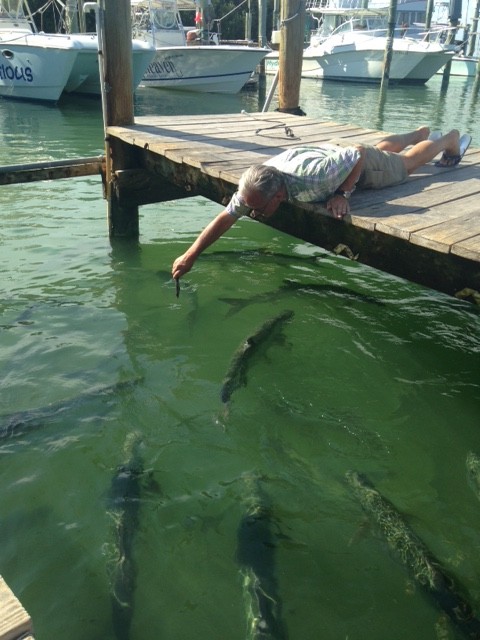
In its 113-mile journey from Key Largo southwestward to Key West, Florida’s Overseas Highway never fails to delight the senses of sun-starved snowbirds with sparkling blue and green tropical waters, lush tropical vegetation, and seemingly endless sea and sky vistas. Nor is the roadway itself anything less than spectacular, traversing as it does three dozen, narrow, low-slung islands and 42 causeway bridges, the longest of which is nearly seven miles.
But in their enjoyment of the trip and their eagerness to get to hip and happening Key West, most travelers overlook the many worthwhile sites along the federally-recognized All-American Road that also serves as the inaugural stretch of U.S. Route 1, sites that are much more representative of the truly unique ecosystem and culture that is the Florida Keys. Profiled below are ten of the more worthwhile stops to consider the next time you head off into the tropical sunset.
N.B. U.S. Route 1 officially begins in downtown Key West at Mile Marker (MM) 0. Addresses on the Overseas Highway, therefore, are calculated by how far they are from Key West, with “bayside” referring to the northern side of the road, toward the Bay of Florida, and “oceanside” referring to the southern side, toward the Atlantic Ocean.
- John Pennekamp Coral Reef State Park, Key Largo (MM 102.5 oceanside); 305-451-6300. Entrance fee: $8 per vehicle.
The best place to see the continental US’s only living barrier reef, which lies 3-8 miles offshore, is at America’s first undersea park. And if you’re not a certified diver, the best way to do it is via a 2 ½ hour ($29.95 adults, $24.95 under 18) or 4 ½-hour ($38.95 per person) snorkeling tour (equipment not included) or a 2 ½-hour glass bottom boat tour ($24 adults, $17 ages 4-11). Likewise, you can explore the park’s 50 miles of mangrove swamps via rented canoes, kayaks, or paddle boards. Onshore attractions include nature trails, two beaches, and a 30,000-gallon saltwater aquarium. (Note: the iconic Christ of the Deep statue is accessible only on snorkeling tours.)
- African Queen, Marina del Mar Marina, Key Largo (MM 100 oceanside); 305-451-8080.
Film buffs of a certain age will enjoy checking out the original 1912 “African Queen,” the 30-foot steamboat that starred (along with Humphrey Bogart and Katharine Hepburn) in the 1951 movie of the same name. 1 ½-hour canal cruise ($49), 2 ½ hour dinner cruise ($89 though dinner is not on the boat.)
- Key Lime Products, Key Largo (MM 95.2 oceanside); 305-853-0378.
Until the hurricane of 1926, these small, yellowy limes were indeed grown commercially throughout the Keys. Now most come from Mexico, but that doesn’t stop local entrepreneurs from cultivating a veritable cornucopia of Key lime products, including candies, cookies, ice cream, tea, jelly, candles, and of course Key lime pie. This colorful, low-key roadside emporium offers a wide selection at very reasonable prices.
- Any number of resorts in Islamorada and Marathon (MM 88-57)
Lured onwards by the evening and night life in Key West, most motorists don’t even consider overnighting anywhere else. What they end up missing is the opportunity to recreate at will and at length at dozens of all-inclusive beachfront resorts. (“All-inclusive” refers to amenities such as swimming pools, tennis courts, kayaks, paddleboards, snorkeling equipment, and bicycles, NOT food and drink. Jet skis and sailboats are not included and there’s invariably a resort fee.) Among the best family-oriented options are the Pelican Cove (305-664-4435) and Postcard Inn (305-664-2321) both on Windley Key; the Chesapeake Beach (305-664-4662) and the Cheeca (305-664-4651), both on Upper Matecumbe Key; and the Caribbean-style (and sized) Hawks Cay (305-743-7000) on Duck Key, which even has its own dolphin encounter.
- Theater of the Sea, Windley Key (MM 84.5 bayside); 305-664-2431.
For 70 years now, Theater of the Sea has been entertaining Overseas Highway travelers (and especially those in the back seat), with its stunt-studded dolphin, sea lion, and parrot shows. Beginning in 1987, they began adding interactive encounters, first with dolphins, and eventually with sea lions, rays, sharks, and most recently, sea turtles. General admission to the grounds and all shows: $31.95 ages 11 and up, $21.95 ages 3-10. Encounter prices vary, but the most popular dolphin ones run $195 to swim, $180 to wade, and $85 to meet (you don’t get in the water). Similar marine mammal encounters can be had at Dolphins Plus, Key Largo (MM 99.5 oceanside and MM 102 bayside); 305-451-1993, dolphinsplus.com; and the Dolphin Research Center, Grassy Key (MM 59 bayside); 305-289-0002, dolphins.org.
- Florida Keys History of Diving Museum, Upper Matecumbe Key (MM 83 bayside); 305-664-9737.
Much of the Keys’ early wealth came from salvaging wrecks, and this quirky but comprehensive museum traces the 4,000-year history of diving and underwater exploration in all four aspects: military, commercial, treasure, and recreational. Among the many fascinating exhibits are a replica of Edmund Halley’s 1691 diving bell, the Mark V Navy helmet, and some of the 18th-century finds of local treasure hunter Art McKee. Admission: $12 adults, $6 ages 5-11
- Pierre’s Restaurant/Morada Bay Beach Café, Upper Matecumbe Key (MM 81.6 bayside); 305-664-3225.
The Keys are full of waterfront dining opportunities, but few can hold a Tiki torch to the charming white-sand beach and wide open views out over island-studded Florida Bay offered at these two upscale, adjacent sister properties in Islamorada. Take your choice of the two verandahs at plantation-style Pierre’s or dine right in the sand at the Beach Café. Both are especially appealing at sunset. Dinner entrees: $26-55.
- Robbie’s of Islamorada, Lower Matecumbe Key (MM 77.5 bayside); 305-664-8070.
Serious anglers come to Robbie’s for some of the best sport fishing in the country, but fun-loving tourists stop by to eat at the Hungry Tarpon Restaurant, shop at the open air market, and hand feed the 2-5 foot-long domesticated tarpon that congregate under the public dock. (Admission to dock $1, bucket of bait fish $3.) Also available are snorkeling tours and a 2 ½–hour excursion to deserted Indian Key Historic and Lignumvitae Botanical State Parks ($37.50 per person plus a single $7 state park entrance fee).
- Bahia Honda State Park, Bahia Honda Key (MM 37 oceanside); 305-872-3210.
Among the Keys’ most naturally attractive and best maintained beaches are the three of 524-acre Bahia Honda State Park, which allow for swimming, snorkeling, and extended beachcombing on both the bay and ocean sides. You can also venture out high over Bahia Honda Channel on the original 1912 rail bridge, which was converted to cars in 1938 before being retired (by having two sections removed) in 1972. Entrance fee: $8 per vehicle
- National Key Deer Refuge, 179 Key Deer Blvd., Big Pine Key (MM 30 bayside); 305-872-0774.
The visitor center for this sprawling, 25-island refuge devoted to preserving the endangered Key deer, a variant of the Virginia white-tailed reduced by the harsh environment to the size of a large dog (roughly 45-75 pounds), is located in the Big Pine Key Shopping Center. To actually see some deer, however, you’ll need to walk one of the two nature trails (Jack C. Watson and Blue Hole) located north on Key Deer Avenue or cruise slowly through the nearby residential areas on Big Pine and No Name Keys. Free.
INFO: Florida Keys and Key West Visitors Bureau, 800-352-5397.
Stacie Berdan Launches New Go Global Video
Posted on Jan 5, 2016

My latest “Go Global” video was developed with K-12 educators in mind. Teachers can use it in their classrooms to inspire global thinking and action. Administrators can share it with local legislators and policy makers to challenge them to do more for students. Parents can watch it for tips on how to help their children develop a global mindset. I encourage you to use it and spread the word!
A Travel-inspired Gift-giver’s Guide for Globetrotters
Posted on Dec 15, 2015

By Morgan Abate
As the final week of the holiday season begins, I find myself stumped on a gift for a good friend of mine. His family made traveling a priority growing up, and thus it has evolved to be an important part of his life. He wants to continue traveling, learning about different cultures and opening up his mind.
Knowing this about him, I wanted to come up with a gift that encompassed his love for travel, the places, cities and countries he has explored, and his future plans for travel. At first, I tried thinking of gifts off the top of my head. The ideas weren’t original, creative or neat. When I had exhausted my energy thinking, I turned to Pinterest, a great resource for anything original and creative.
Sure enough, multiple searches involving “travel” yielded hundreds of results. Some of them were crafty while others were useful and practical. Not only did I end up finding great gift ideas for my friend, but also future ideas for family members and other friends.
Passport covers– One of the best gifts I have received was a passport cover. It helps tell passports apart in a family or in a crowd. MindMap, an online shop on Etsy, the entrepreneurial hub for original goods, sells handmade leather passport covers, wallets and magnets—among other things—with travel themes. Each leather cover costs between $25-$30 and fits U.S., U.K., Canadian, European, Australian and Singaporean passports. If you’ve never ordered from Etsy, don’t worry. MindMap has more than 250 reviews and 2,200 sales. A search for leather passport covers can also lead you to other cool, crafty items.
Scratch maps – Some people love to track and mark the places they have visited in the world. Sometimes it can be as simple as hanging a laminated map and using stickers or tacks to mark the spots they have been. Mix it up a bit! Scratch Maps sells maps of the United States, Europe and other regions around the world for you to scratch away the countries—or even parts of a country—that you have traveled to. The maps cost $28 to $40. They also sell products like scratch journals with cards for each continent.
PANDORA charms & cufflinks – Jewelry to commemorate where you, a friend or a loved one has been or to simply tap into the travel bug can be a perfect gift, even if it is on the more expensive side. For men looking for a classy gift for a mom, sister, girlfriend, fiancée or wife, PANDORA has beautiful travel charms that represent travel in general, specific countries and traditional symbols associated with certain places, such as the Statue of Liberty in New York City. Ladies searching for something for the men in their lives can look to cufflinks. Most of them are basic in design, such as globes or airplanes, but Etsy has a few shops that sell customizable, handmade cufflinks if you’re looking for something more personal.
Scrapbox – For those with a little more time on their hands and a creative side, Martha Stewart has directions for a travel keepsake box. If you know someone who keeps ticket stubs, prints out photos and holds onto other mementos of their travels but has not organized them into a scrapbook, you can make them a simple box with the name of the city or country on it.
Photo coasters – As someone who has access to digital copies of photos from family vacations, this idea is quite appealing. If you have access to photos from a family vacation/exploration, a son or daughter’s abroad experience, or a friend’s favorite travel destination, Shutterfly makes it easy to create coasters as a way to remember travel highlights. They are available in sets of four for $19.99. Just upload the photos and crop them to your liking.
Puzzles – I love puzzles. They are great presents for those who like to think and great activities for families and friends looking for quality time and less screen time. Ravensburger has a one-of-a-kind, 540-piece 3D Earth Puzzleball for $44.45 on Amazon. The Ravensburger website also has a plethora of puzzles of landmarks, rivers, castles, cities and maps.
Maps barware – Uncommon Goods is a company that sells exactly what its name suggests. The site sells map glassware with the streets of Atlanta, Berlin, Chicago, Dublin, Hong Kong, London, Montreal, New Orleans, Paris, Rio de Janiero, Sydney, Washington, D.C. and many more cities. Some glassware also has topographical maps of some of the most well-known sites in the world, such as Machu Picchu, Krakatoa, the Grand Canyon and Mount Everest. There are pint glasses, carafes, wine glasses, lowball glasses, mason jars and mugs, with the selection varying depending on the city or site.
National Geographic Atlas of the World – Last year, Nat Geo published its tenth edition of its atlas to celebrate 100 years of cartography. It’s chock-full of maps, data, trends and facts about the world in which we live. This is a fantastic gift for the family and friends who love learning and educating themselves and others about the world. Not only is it useful for learning, but also to help plan future travels.
iPhone camera lenses – Lifehack, a tech and media website, published a list of the best attachable lenses for your phone. They vary in price, but allow you to take almost-DSLR-quality photos on your phone without needing to carry an extra piece of equipment along with you. If you know someone who likes to document their travels—or even their lives—in photos, this would be a perfect gift. Consider including a little case for the lenses so they don’t get lost.
Biaggi bags – When you’re traveling around a country, staying in small hostels, it can be hard to find space for your luggage. Or when you’re storing your luggage until the next trip, it may need its own closet because of how much space it fills. Biaggi bags, made famous through Shark Tank, were created to eliminate this problem. The luggage fits everything you need, and when you no longer need it, it folds into a neat handheld bag until next time.
TAXI wallet – The Grommet is a quirky website with a bunch of niche gift ideas, and this is one of them. The TAXI wallet is thin with just enough space for an ID, the cards you need and some cash. It folds up and can fit on any part of your person.
After searching for and thinking about the perfect gift for my friend, these ideas offer me a much better idea of what I can give him that is both personal and original. There are, of course, plenty more ideas. This list serves a starting point for those looking for travel-inspired gifts for just about anyone!
Morgan Abate is a soon-to-be graduate of Elon University hoping to pursue a career in international communications and cause marketing. She is fluent in Spanish and English, and is currently teaching herself Portuguese to be able to live in work in Brazil, the business hub of Latin America.
